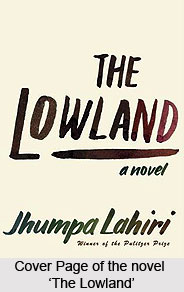 `The Lowland` is a beautiful narrative which portrays the emotional journey of Indian immigrants or Non-residential Indians or NRIs, who are making an attempt to adapt and adept themselves to the alien lifestyles of the foreign shores. The novel is one such narrative that often leads a reader to a moment of unnerving silence as Shashi Deshpande had observed in the novel, `That Long Silence`. Jhumpa Lahiri, the author of `The Lowland` has captured the intricate details of the central characters. Silence is often deafening and uneasy that echoes within the labyrinths of the narrative, `The Lowland` as Lahiri even casts the canvas of political violence as she brings in the contemplative panorama of the Naxalite movement that shook Bengal to bombarding upsurge in the 70`s era.
`The Lowland` is a beautiful narrative which portrays the emotional journey of Indian immigrants or Non-residential Indians or NRIs, who are making an attempt to adapt and adept themselves to the alien lifestyles of the foreign shores. The novel is one such narrative that often leads a reader to a moment of unnerving silence as Shashi Deshpande had observed in the novel, `That Long Silence`. Jhumpa Lahiri, the author of `The Lowland` has captured the intricate details of the central characters. Silence is often deafening and uneasy that echoes within the labyrinths of the narrative, `The Lowland` as Lahiri even casts the canvas of political violence as she brings in the contemplative panorama of the Naxalite movement that shook Bengal to bombarding upsurge in the 70`s era.
The shadow of Mahasweta Devi`s `Hazaar Chaurasi Ki Maa` and Samaresh Mazumdar`s `Kaalbela` falls abruptly on the nooks and corners of the novel. The novel is all about existentialism, choosing a path of their own choice and inviting all the responsibilities associated with the path. One, a family man and the other a radical - both are siblings yet both nourish a dissimilar life force. Like `Gogol` in `The Namesake`, the protagonists of `The Lowland` face the un-faced, travel the less travelled path and hence take a route only to reach the roots. Jhumpa Lahiri has been following a genre that is termed as diasporic literature. Diaspora may be termed as a narrative structure that traces the journey of the self willed crusaders of existentialism who have had chosen this life owing to their perennial love for exile. The deep diving penetration into the psyche, the complexities of existence and the pain that is intermittent among the relations is what shapes Lahiri`s novels. `The Lowland` is no exception.
Synopsis of `The Lowland`
The book was published in 2013. Udayan, the protagonist of the novel meets a tragic end, after he becomes a victim to the Mao-infested rebellious politics. Following his sudden demise, his brother Subhash marries his pregnant wife Gauri, who is filled with resentment and treats Subhash with cold contempt. While Udayan has been depicted as the adventurous, impulsive brother, the character of Subhash is a sharp contrast as he is quite practical. Jhumpa Lahiri`s graceful dexterity in capturing the realities of life and injecting life into the characters is reflected in the very framework of the novel. Gauri turns out to be a withdrawn woman who abandons her daughter Bela to achieve her goals of a bright, academic career.
Central Idea of `The Lowland`
According to the author Jhumpa Lahiri, the foundation of `The Lowland` is in India, where Lahiri had visited frequently during her early youth. It was in this country that she had learnt about a passionate account of how two brothers were executed brutally, near her grandparent`s house in the city of Kolkata, following their association with a turbulent political movement. The novel has earned accolades and has been nominated for the 2013 Man Booker Prize.
The novel remains to be one of the sought after picture of life due to its lyrical and evocative scenes of chromosomes of Kolkata and the political history adopted, as a means of narrative to platform the renaissance called `Naxal` movement.



















